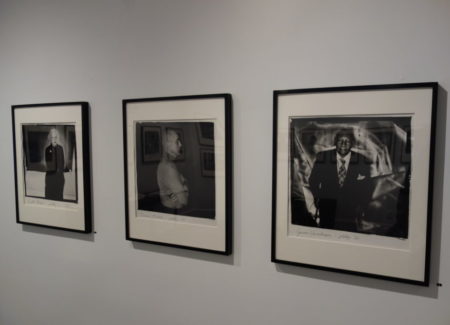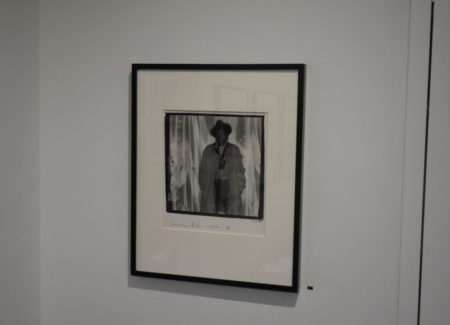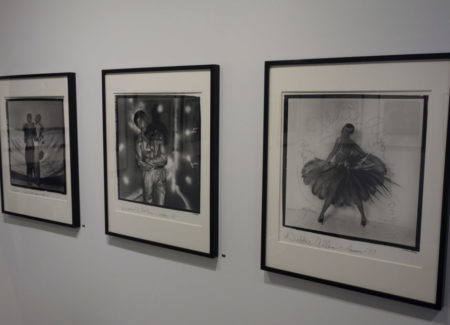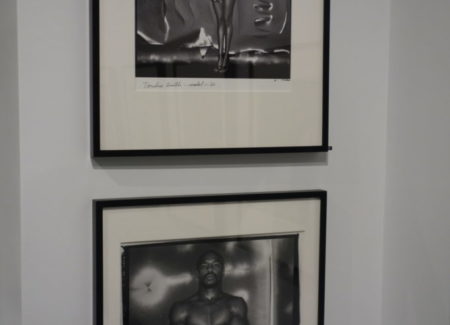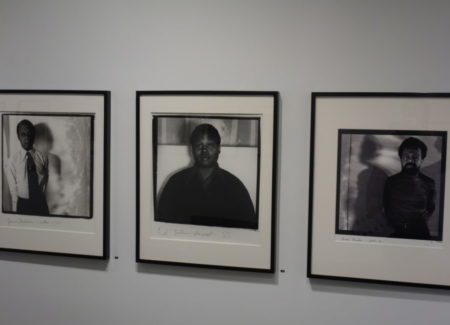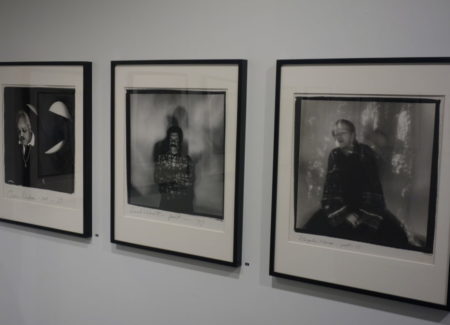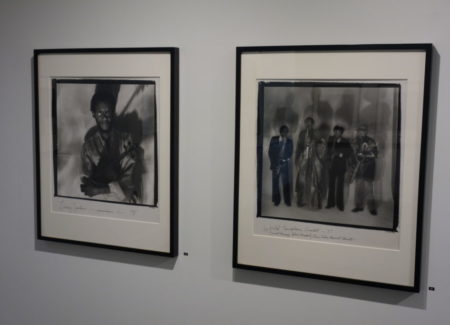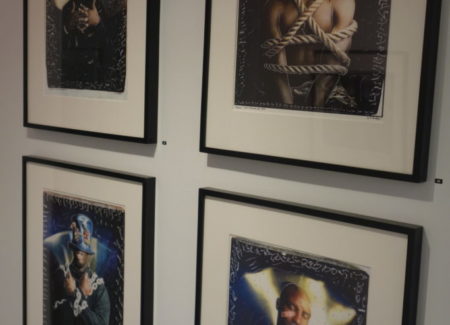JTF (just the facts): A total of 29 black-and-white and color photographs, framed in black and matted, and hung against white walls in the main gallery space. 25 of the works are gelatin silver prints, made between 1975 and 1981. Most of the prints are vintage, and sized 20×16 or 14×11 inches, with no edition information available; a handful are modern inkjet prints made in 2017, sized 19×13 inches, and available in editions of 5. The 4 color works are modern inkjet prints made in 2017 from negatives taken in 1993. These prints are also sized 19×13 inches, and are available in editions of 5. (Installation shots below.)
Comments/Context: The opportunities and challenges faced by the studio portrait photographer are in some sense one and the same. Having stripped away the surroundings, settings, and contexts of the outside world, the photographer is offered a blank space in which to create an entirely new aesthetic situation. But with that open-ended freedom comes the complexity of how to impose a unique personal vision on the straightforward reality of a single figure standing in front of a camera.
The inspired solutions to this thorny problem deservingly populate the history books of the medium. Irving Penn created a narrow corner in which to stuff his portrait subjects. Malick Sidibé offered his sitters groovy props and bold patterns. Richard Avedon introduced the stark flatnesss of an undifferentiated white background. Philippe Halsman made his subjects jump. Thomas Ruff enlarged the heads to unexpectedly massive scale. And in each case, the photographer found a way to both celebrate the individuality of the sitter and add something new to the visual equation.
Anthony Barboza’s images of artists, writers, musicians, athletes, and other celebrities from the late 1970s offer another singular approach to the studio portrait exercise. Barboza got his photographic start in New York in the early 1960s, and was (and still is) a key member of Kamoinge, a professional organization working to support black photographers in the art world. The Black Borders series was named for the visible black borders of the film that surround each sitter, and the commonality of that framing technique creates a sense of continuity and artistic blending between the various subjects when the pictures are shown together.
But what sets these photographs apart, and gives them their durable vitality, is their innovative use of lighting and backgrounds. While the instinct of many commercial photographers would be to minimize the distracting effect of the shadows cast by the studio lights, Barboza does just the opposite, turning the dark distorted forms into expressive echoes of the sitters. Underneath setups create shadows that loom above and behind Normal Lewis, Derek Walcott, Leroy Jenkins, and the World Saxophone Quartet, while side arrangements turn the shadows into repetitions and echoes, doubling Benny Andrews, Amiri Baraka, and James Baldwin. Barboza then went on to add a bit of blur to some of the portraits, creating the appearance of back and forth motion or elusive ghosting to Ntozake Shange and Pharoah Sanders.
The backdrops that Barboza created and employed were equally unorthodox. Rolls of hanging paper were cut, slashed, and sliced, creating abstract patters of squiggles, lines, and openings, and then overpainted with expressive dashes and arcs of silvery spray paint, not unlike the interventions John Divola made in abandoned houses. So James Van Der Zee is surrounded by a whorling swirl of shining light, Toukie Smith shares the stage with snake-like back-and-forth forms, Owen Dodson’s white shirt collar matches the high contrast cuts behind him, and Marvin Hagler stands forcefully in front of an array of silvery spots. In other cases, Barboza used glimmery fabrics as backdrops, their reflected shine creating almost gilded effects behind Gordon Parks and James Baldwin.
A small group of more recent color works by Barboza shows him extending these ideas even further. While his sitters have now become more symbolic concepts rather than particular people, the surroundings are even more elaborately planned. Bright flares of light fall behind the standing men, almost like overpowering flashes or angelic bursts, and the sides of the images have been scraped and scratched in repetitive decorative patterns (these prints are rescans of original large scale Polaroids, where Barboza intervened in the emulsion when they were still wet). These hand-made effects provide connections to the chains and ropes that bind some of the sitters or the tape that closes their mouths, adding to the overall sense of frenetic stifled energy.
In nearly all of the images from the Black Borders series, we see Barboza actively engaging in an aesthetic dialogue with each sitter, trying to find a motif that would complement the essential points of character he wanted to highlight. Unlike many of the other giants of photographic portraiture across the history of the medium who developed a formula and then forced sitters to conform to that contrived situation, Barboza seems to have been much more fluid, allowing the creative process of picture making to generate new and different outcomes each time. The result is a set of portraits that feel surprisingly intimate and personal, with one artist taking the risk of boldly interpreting another.
Collector’s POV: The prints in this show are priced as follows. The vintage black and white works sized 20×16 inches range in price from $5000 to $7500; the 14×11 inch vintage prints are $5500. The modern black and white prints are $5000 each. The color prints are $5500 each. Barboza’s work has little consistent secondary market history, so gallery retail remains the best option for those collectors interested in following up.


